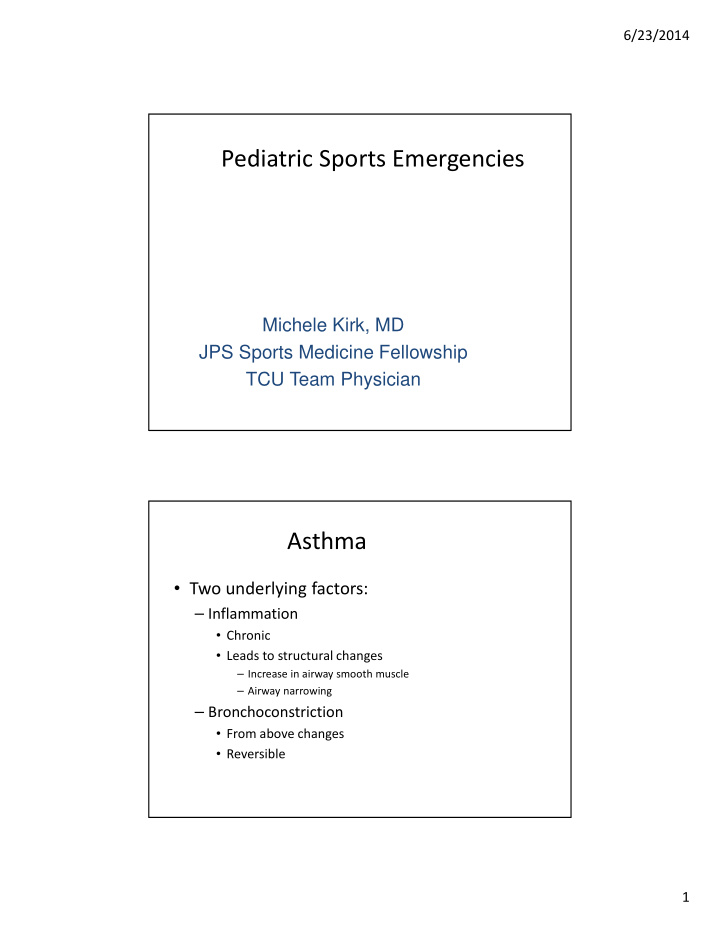



6/23/2014 Pediatric Sports Emergencies Michele Kirk, MD JPS Sports Medicine Fellowship TCU Team Physician Asthma • Two underlying factors: – Inflammation • Chronic • Leads to structural changes – Increase in airway smooth muscle – Airway narrowing – Bronchoconstriction • From above changes • Reversible 1
6/23/2014 Asthma Detecting an Exacerbation: Symptoms • Coughing, persistent • Wheezing • Chest tightness • Shortness of breath • Decreased performance • Increased respiratory rate • Retractions 2
6/23/2014 Focused History • Cause • Time of onset • Meds • Use of beta agonists, recency • Risk factors for severe, uncontrolled dz – ER visits, hospitalizations, intubation hx, rapid progression of sx Focused Examination • Vitals and pulse ox • Level of consciousness, anxiety, agitation • Assess for breathlessness, wheezing, retractions, air entry 3
6/23/2014 Initial Treatment • Short-acting beta agonist – 2-4 puffs of albuterol, 1.25-2.5 mg – Administer each puff separately – May used MDI, with spacer, or nebulizer – Make sure med is not expired or inhaler empty – Reassess in 10-20 mins Initial Response • Good – If symptoms resolve (for 4 hours) and peak flow improves, continue watching and with current treatment – Oral steroids not generally recommended – Remove stimulus, if possible – Consider quadrupling dose of inhaled steroid, if on one 4
6/23/2014 Initial Response • Incomplete – Initiate oral steroids (early) – Continue short-acting beta agonists • Up to every 2 hours for 6-8 hours after initiating oral steroids – Remove stimulus, if possible Initial Response • Poor response – Immediate referral to ED • Severe symptoms • High risk for severe/fatal attacks – Continue administering short-acting beta agonists – Initiate oral/IV steroids asap 5
6/23/2014 Asthma Pearls • Know who has asthma • Know the severity of your athlete’s asthma • Know their triggers • Know how to use an inhaler correctly and how to teach someone to use it • Make sure they carry their meds with them (and their peak flow meter if possible) • Have a copy of the action plan (if they have one) • Best treatment plan for exacerbation is Prevention! 6
6/23/2014 Cervical Spine Injuries Cervical Spine Injuries • Cause of trauma by age: – Birth-vaginal deliveries in breech – Birth to 8 yo-MVCs and falls – 8 yo and up-MVCs and sports • Football, hockey, wrestling • Mechanism of Injury: – Hyperflexion: most common – Hyperextension – Axial loading – Rotation – Chin trauma 7
6/23/2014 Symptoms • Pain • Muscle spasm • Decreased ROM • Weakness • Paresthesia • Asymptomatic or cannot voice/explain their sx Physical Exam • Vital Signs • Neck exam – TTP (location), deformities, spasm • Neuro exam – Tone – Strength: wrist dorsiflexion (C6), elbow extension (C7), knee extension (L2-4), great toe dorsiflexion (L5) – Sensation-isolated deficit most common finding with cervical spine injury – Reflexes-areflexia indicates spinal cord injury 8
6/23/2014 C-spine Immobilization • Head and neck in neutral position – Do NOT reduce obvious deformities – Apply rigid cervical collar • Appropriate size • Should not interfere with airway • Special considerations – Large head size – Prominent occiput in younger children • Special backboards to accommodate 9
6/23/2014 C-spine Immobilization • Log Roll-prone • Lift and slide-supine C-spine Immobilization • Do NOT remove the helmet – Football, ice hockey, lacrosse – Unless remove helmet and shoulder pads together – Remove face mask only • Minimize head motion during transport – Towels, foam rollers/pads, tape 10
6/23/2014 Blunt Abdominal Trauma • Children at greater risk – Compact torsos – Smaller anterior-posterior diameter – Larger viscera, less fat, and weaker musculature • Low risk in sports; higher from MVCs, falls 11
6/23/2014 Blunt Abdominal Trauma • Must have high degree of suspicion – Pay close attention to hx and PE • ABCs first • Abdomen: secondary survey – Pain, distention, bruising, abrasions, referred pain, rigidity, masses Splenic Blunt Trauma • Anatomy – Lateral and posterior to the stomach 12
6/23/2014 Splenic Injuries • Types of injuries – Contusion – Hematoma – Laceration • (grades I-V) – Rupture-Mono! Splenic Injuries • Signs and symptoms – Left flank/upper quadrant pain – Referred pain to left shoulder with palpation and/or inspiration – Increased HR and diastolic BP – Rebound and/or guarding on abdominal palpation 13
6/23/2014 Splenic Injuries • Treatment – Send to ED – Labs, imaging – Definitive tx depends on grade of injury/hemodynamic stability Hepatic Abdominal Trauma • Anatomy 14
6/23/2014 Hepatic Injuries • Types of injuries Grading System – Contusion – Hematoma – Laceration • Signs/sx – Referred pain to right shoulder, RUQ pain – Rebound and/or guarding – Increased HR, decreased BP Hepatic Injuries • Treatment – Send to ED – Labs, imaging – Definitive tx depends on grade of injury/hemodynamic stability 15
6/23/2014 Renal Abdominal Trauma • Anatomy Renal Injuries • Types of Injuries • Grading system – Contusion – Hematoma – Laceration • Signs/Sx – Flank pain – Hematuria – Rebound/guarding – Increased HR, decreased BP 16
6/23/2014 Renal Injuries • Treatment – Send to ED – Labs, imaging – Definitive tx depends on grade of injury/hemodynamic stability 17
Recommend
More recommend